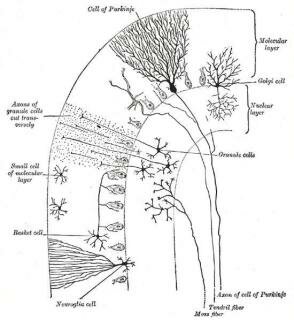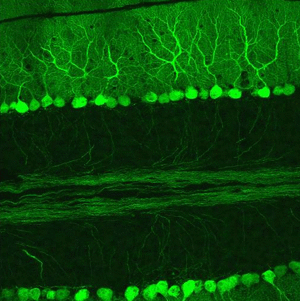| Why the Uncoordinated Walk and the Headshaking (Tremors) ? - viewed 15670 times |

|

|
|
Purkinje Cells are large neurons aligned like dominos stacked one in front of the other within the Purkinje Layer which allows communication via electrical impulses between the in the cerebellum. These cells are initially formed before birth and continue to grow their branch-like folia for aproximately 90 days post natum. See diagram below for growth period from Birth (PO), 3 days (P3), 6 days (P6) etc. to 90 days (P90). The number of damaged or degenerated Purkinje cells regulates the level of severity of the ataxia and other clinical signs expressed with cerebellar abiotrophy, based on the electrical impulses transferred. Although an animal can survive with a complete removal of the cerebellum, it is not self sufficient.
Each Purkinje cell receives excitatory input from 100,000 to 200,000 parallel fibers. Parallel fibers are said to be responsible for the simple (all or nothing, amplitude invariant) spiking of the Purkinje cell. With the neurological disorder of cerebellar abiotrophy, the apoptosis of the Purkinje cells is so great that what scant number of cells are left are usually small and shruken. This prevents the ability to make any fine-tuned movements and leads to head tremors (intention tremor especially on goal directed movements), a lack of balance equilibrium (ataxia), and a lack of a menace reflex with the eye lids
© EG-C, 02-IV-09.
|
 Head Tremors
Head Tremors

 The saggital section below shows where the Purkinje Cell layer exists in the cerebellum with the following enlargement of the saggital section showing the molecular layer with multiple Purkinje cells. The final photo is a confocal micrograph from a cerebellum expressing green-fluorescent protein in Purkinje cells. One can clearly see the heavily intertwined folia/branches of each cell and how they are dependent upon one another.
The saggital section below shows where the Purkinje Cell layer exists in the cerebellum with the following enlargement of the saggital section showing the molecular layer with multiple Purkinje cells. The final photo is a confocal micrograph from a cerebellum expressing green-fluorescent protein in Purkinje cells. One can clearly see the heavily intertwined folia/branches of each cell and how they are dependent upon one another.


